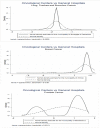Predictive Assessment of Cancer Center Catchment Area from Electronic Health Records
- PMID: 29201863
- PMCID: PMC5696335
- DOI: 10.3389/fpubh.2017.00303
Predictive Assessment of Cancer Center Catchment Area from Electronic Health Records
Abstract
Healthcare facilities (HF) may identify catchment areas (CA) by selecting criteria that depend on various factors. These refer to hospital activities, geographical definition, patient covariates, and more. The analyses that were traditionally pursued have a limiting factor in the consideration of only static conditions. Instead, some of the CA determinants involve influences occurring at both temporal and spatial scales. The study of CA in the cancer context means choosing between HF, usually divided into general hospitals versus oncological centers (OCs). In the CA context, electronic health records (EHRs) promise to be a valuable source of information, one driving the next-generation patient-driven clinical decision support systems. Among the challenges, digital health requires the re-definition of a role of stochastic modeling to deal with emerging complexities from data heterogeneity. To model CA with cancer EHR, we have chosen a computational framework centered on a logistic model, as a reference, and on a multivariate statistical approach. We also provided a battery of tests for CA assessment. Our results indicate that a more refined CA model's structure yields superior discrimination power between health facilities. The increased significance was also visualized by comparative evaluations with ad hoc geo-localized maps. Notably, a cancer-specific spatial effect can be noticed, especially for breast cancer and through OCs. To mitigate the data distributional influences, bootstrap analysis was performed, and gains in some cancer-specific and spatially concentrated regions were obtained. Finally, when the temporal dynamics are assessed along a 3-year timeframe, negligible differential effects appear between predicted probabilities observed between standard critical values and bootstrapped values. In conclusion, for interpreting CA in terms of both spatial and temporal dynamics, sophisticated models are required. The one here proposed suggests that bootstrap can improve test accuracy. We recommend that evidences from stochastic modeling are merged with visual analytics, as this combination may be exploited by policy-makers in support to quantitative CA assessment.
Keywords: bootstrap; cancer patients; catchment area; multivariate adaptive regression splines; testing.
Figures






Similar articles
-
Assessment and statistical modeling of the relationship between remotely sensed aerosol optical depth and PM2.5 in the eastern United States.Res Rep Health Eff Inst. 2012 May;(167):5-83; discussion 85-91. Res Rep Health Eff Inst. 2012. PMID: 22838153
-
Evaluating heterogeneity in indoor and outdoor air pollution using land-use regression and constrained factor analysis.Res Rep Health Eff Inst. 2010 Dec;(152):5-80; discussion 81-91. Res Rep Health Eff Inst. 2010. PMID: 21409949
-
Development and application of an aerosol screening model for size-resolved urban aerosols.Res Rep Health Eff Inst. 2014 Jun;(179):3-79. Res Rep Health Eff Inst. 2014. PMID: 25145039
-
A discussion of calibration techniques for evaluating binary and categorical predictive models.Prev Vet Med. 2018 Jan 1;149:107-114. doi: 10.1016/j.prevetmed.2017.11.018. Epub 2017 Nov 24. Prev Vet Med. 2018. PMID: 29290291 Review.
-
[Aiming for zero blindness].Nippon Ganka Gakkai Zasshi. 2015 Mar;119(3):168-93; discussion 194. Nippon Ganka Gakkai Zasshi. 2015. PMID: 25854109 Review. Japanese.
Cited by
-
A Machine Learning-Based Predictive Model for Predicting Lymph Node Metastasis in Patients With Ewing's Sarcoma.Front Med (Lausanne). 2022 Apr 6;9:832108. doi: 10.3389/fmed.2022.832108. eCollection 2022. Front Med (Lausanne). 2022. PMID: 35463005 Free PMC article.
-
Data Analytics to Support Policy Making for Noncommunicable Diseases: Scoping Review.Online J Public Health Inform. 2024 Oct 25;16:e59906. doi: 10.2196/59906. Online J Public Health Inform. 2024. PMID: 39454197 Free PMC article.
References
-
- Norris D, Levy D. Precision medicine is a value-of-information and vice-versa. J Prec Med (2015) 1(1):57–63.
LinkOut - more resources
Full Text Sources
Other Literature Sources
Research Materials
Miscellaneous

